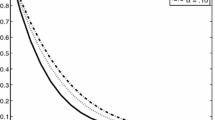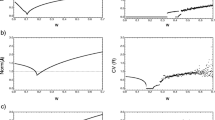Abstract
The maximum principle of deterministic optimal control, which has proved to be a very useful tool in theoretical bioeconomics, is extended in this article to cover the optimal exploitation of a biological resource vulnerable to catastrophic collapse, the probability of which may depend in general on the state of the resource, the current control and time. A general formulation of the maximum principle for such stochastic problems is presented and a number of applications are outlined. These include: optimal harvesting of a fishery vulnerable to catastrophic collapse; optimal thinning of a forest vulnerable to fire; optimal expenditure and investment in forest fire protection and optimal consumption-pollution tradeoffs in an ecosystem vulnerable to pollution-related collapse. In addition an application of the method to a highly stylized behavioral ecology model is given.
Similar content being viewed by others
Literature
Anderson, P. and J. Sutinen. 1984. Stochastic bioeconomics: A review of basic methods and results.Mar. Res. Econ. 1, 117–136.
Apaloo, J. 1988. Management of a forest stand: Determination of optimal thinning rate, fertilization rate and rotation age in the presence of risk of catastrophic destruction. M.Sc. Thesis, University of Victoria.
Brock, W. A., M. Rothschild and J. E. Stiglitz. 1988. Stochastic capital theory. InEssays in Honour of Joan Robinson, G. Feiwal (Ed.). Cambridge: Cambridge University Press.
Clark, C. W. 1976.Mathematical Bioeconomics: The Optimal Management of Renewable Resources. New York: Wiley-Interscience.
Clark, C. W. 1985.Bioeconomic Modelling and Fisheries Management. New York: Wiley-Interscience.
Clark, C. W. and J. D. DePree. 1979. A simple linear model for the optimal exploitation of renewable resource.Appl. Math. Opt. 5, 181–196.
Conrad, J. M. and C. W. Clark. 1987.Natural Resource Economics. Cambridge: Cambridge University Press.
Forster, B. A. 1973. Optimal consumption planning in a polluted environment.Econ. Record, December, 534–545.
Forster, B. A. 1975. Optimal pollution control with a nonconstant exponential rate of decay,J. Environ. Econ. Mgmt 2, 1–6.
Kamien, M. I. and N. L. Schwartz. 1971. Optimal maintenance and sale age for a machine subject to failure.Mgmt Sci. 17, 495–504.
Kamien, M. I. and N. L. Schwartz. 1981.Dynamic Optimization: The Calculus of Variations and Optimal Control in Economics and Management. New York: North-Holland.
Kushner, H. J. and F. C. Schwieppe. 1964. A maximum principle for stochastic control systems.J. math. Analysis Appl. 8, 287–302.
Mangel, M. 1985.Decision and Control in Uncertain Resource Systems. New York: Academic Press.
Mangel, M. and C. W. Clark. 1988.Dynamic Modeling in Behavioral Ecology. Princeton, New Jersey: Princeton University Press.
Plourde, C. G. 1972. A model of waste accumulation and disposal.Can. J. Econ. 5, 119–125.
Reed, W. J. 1984. The effect of risk on the optimal rotation of a forest.J. Environ. Econ. Mgmt 11, 180–190.
Reed, W. J. 1987. Protecting a forest against fire: Optimal protection patterns and harvest policies.Nat. Res. Model 2, 23–54.
Reed, W. J. 1988. Optimal harvesting of a fishery subject to random catastrophic collapse.IMA J. Math. Appl. Med. Biol. 5, 215–235.
Reed, W. J. 1989. Optimal investment in the protection of a vulnerable biological resource.Nat. Res. Model. 3, 463–480.
Reed, W. J. and J. Apaloo. 1991. Evaluating the effects of risk on the economics of juvenile spacing and commercial thinning.Can. J. Forest. Res. (in press).
Reed, W. J. and H. R. Clarke. 1990.Consumption-pollution tradeoffs in an environment vulnerable to pollution-related catastrophic collapse. UVic Department of Mathematics and Statistics, DMA-554-IR.
Sethi, S. P. 1979. Optimal pilfering policies for dynamic continuous thieves.Mgmt Sci. 535–542.
Thompson, W. A., Jr. 1988.Point Process Models with Applications to Safety and Reliability. New York: Chapman & Hall.
Walters, C. J. 1986.Adaptive Management of Renewable Resources. New York: Macmillan.
Wicksell, K. 1934.Lectures on Political Economy, Vol. 1, General Theory, L. Robins (Ed.). London: George Routledge.
Author information
Authors and Affiliations
Rights and permissions
About this article
Cite this article
Reed, W.J., Heras, H.E. The conservation and exploitation of vulnerable resources. Bltn Mathcal Biology 54, 185–207 (1992). https://doi.org/10.1007/BF02464829
Received:
Revised:
Issue Date:
DOI: https://doi.org/10.1007/BF02464829




